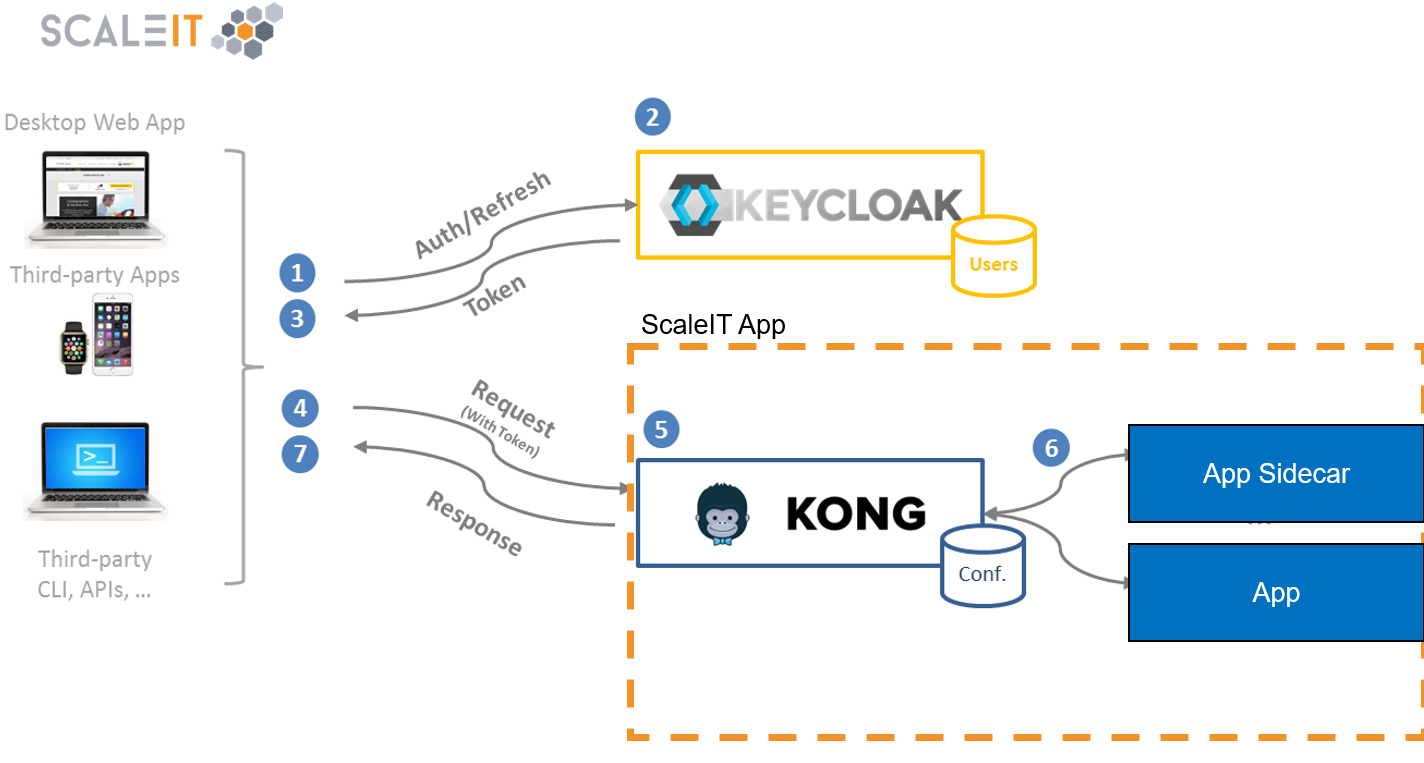This image uses Kong along with Kongfig and the External OAuth Plugin.
This Image is intended to be used as a socalled sidecar image. This means a new Kong instance is created for each app using kong in contrary to using Kong as a centralized load balancer. It also means that the Kong sidecar image has its own database and therefore user, security and other configuration which guarantees a lose coupling between an infrastructure's stacks. This is also shown as a graphical representation below:
To reduce complexity in usage when launching the stack, config files can be provided so you don't have to make API calls (or write your own scripts to do so).
Check out the example app here: https://github.com/ScaleIT-Org/sapp-example-oauth-ready-app
It is recommended to use docker-compose which makes it more easy to handle configurations. Please view this docker-compose.yml snippet below:
version: '2.1' # replace by any version needed (> 2.1)
services:
# <...> your main application/applications here
kong-database:
image: postgres:10.4-alpine # kong requires >9.5
environment:
- POSTGRES_USER=kong
- POSTGRES_DB=kong
- POSTGRES_PASSWORD=kong
volumes:
- db-data:/var/lib/postgresql/data
networks:
- internal
healthcheck: # optional
test: ["CMD", "pg_isready", "-U", "postgres"]
interval: 10s
timeout: 5s
retries: 5
kong:
image: scaleit/kong-sidecar:0.14.0-0
depends_on:
kong-database:
condition: service_healthy # only if healthcheck is enabled
restart: always
ports:
- 8000:8000
- 8001:8001
environment:
- KONG_DATABASE=postgres
- KONG_PG_HOST=kong-database
- KONG_PG_DATABASE=kong
- KONG_PG_PASSWORD=kong
links:
- kong-database:kong-database
volumes:
- "./config:/config/apis"
networks:
- internal
healthcheck: # optional
test: ["CMD-SHELL", "curl -I -s -L http://127.0.0.1:8000 || exit 1"]
interval: 5s
retries: 10
volumes:
db-data:
networks:
internal:
# <...>Consider replacing internal by your main application's internal network and set the newest version for scaleit/kong-sidecar (latest should not be used in production). There is also an alpine variant of this image.
It is recommended to replace KONG_PG_PASSWORD and POSTGRES_PASSWORD by a more secure passphrase.
API Settings have the following format:
apis:
- name: MyApp # unique api name
attributes:
upstream_url: http://<your_app_url>
hosts:
- app.example.com
uris:
- /app
preserve_host: true
plugins:
- name: rate-limiting # kong plugin name
attributes: # the plugin attributes
username: # optional, to reference a consumer, same as consumer_id in kong documentation
config:- "name": Specify your app's name.
- "host" and "uris": Set one of these (or both) to point to your app.
- "upstream_url": Your app's actual URL to be reachable from Kong.
- "preserve_host": Set this to forward the hostname entered by the client to your app.
- "plugins": Apply Kong-Plugins.
Example for using the External OAuth Plugin:
# <...> API config
plugins:
- name: external-oauth
attributes:
config.authorize_url: https://oauth.something.net/openid-connect/authorize
config.scope: openid+profile+email
config.token_url: https://oauth.something.net/openid-connect/token
config.client_id: SOME_CLEINT_ID
config.client_secret: SOME_SECRET_KEY
config.user_url: https://oauth.something.net/openid-connect/userinfo
config.user_keys: email,name,s
config.hosted_domain: mycompany.c
config.email_key: emailYou can also add consumers to your Kong-sidecar instance:
consumers:
- username: client-app
credentials:
- name: key-auth # name of a specific credentials plugin
attributes: # credential config attributesYou can create YAML files with names ending with .yml within any directory and define the settings to the container by defining a bind mount for the folder:
volumes:
- "./<your_config_dir>:/config/apis"Kong-sidecar will look for all YAML-files, like apis.yml or consumers.yml, in /config/apis and apply them.
Optionally you can also define JSON files, however YAML is recommended for a better readability.
After starting the stack, you should be able to reach your app by accessing http://localhost:8000/app.
API Settings should be edited in your apis.yaml file (or however you named it), so the settings are persistent even after container recreation and volume removal.
For a more advanced example go to Kongfig on Github.
Building the image is as easy as running docker build -t teco/kong-sidecar:0.12.1-0 . inside the directory where this repository is cloned. Be free to replace "0.12.1-0" with any tag that fits your needs.
Kong sidecar image version declarations follow the pattern <kong-version>-<kong_sidecar_image-patch> where <kong-version> is the semantic version of kong that is used and <kong_sidecar_image-patch> is a single number suggesting a patch respectively a fix for this image.
-
standard_init_linux.go:185: exec user process caused "no such file or directory": Common problem on windows. Convert line endings in theentrypoint.shandapply-config.shfile to LF and the error will disappear. -
"No kong-apis file found, skipping configuration." although file provided: Occurs on docker for Windows or docker for Mac. Sometimes files are mounted as empty directories. A restart of the daemon can help. Otherwise provide it via volume.
-
Nginx Logs show
upstream sent too big header while reading response header from upstreameven if proxy buffer is disabled: Occurs if theexternal-oauthplugin is enabled and the user is redirected to the OAuth provider (or vice versa). OAuth2 fills the HTTP-header resulting in a header size which is too big to handle by the reverse proxy. Try to increase your proxy buffer as following:
proxy_buffer_size 16k;
proxy_buffers 8 8k;
proxy_busy_buffers_size 16k;



